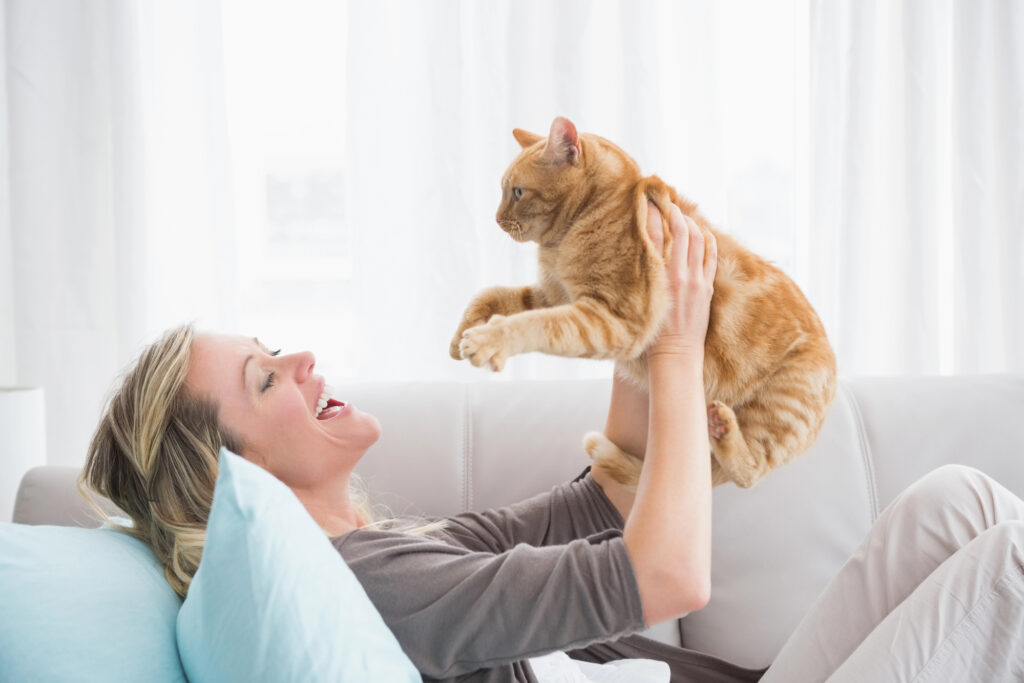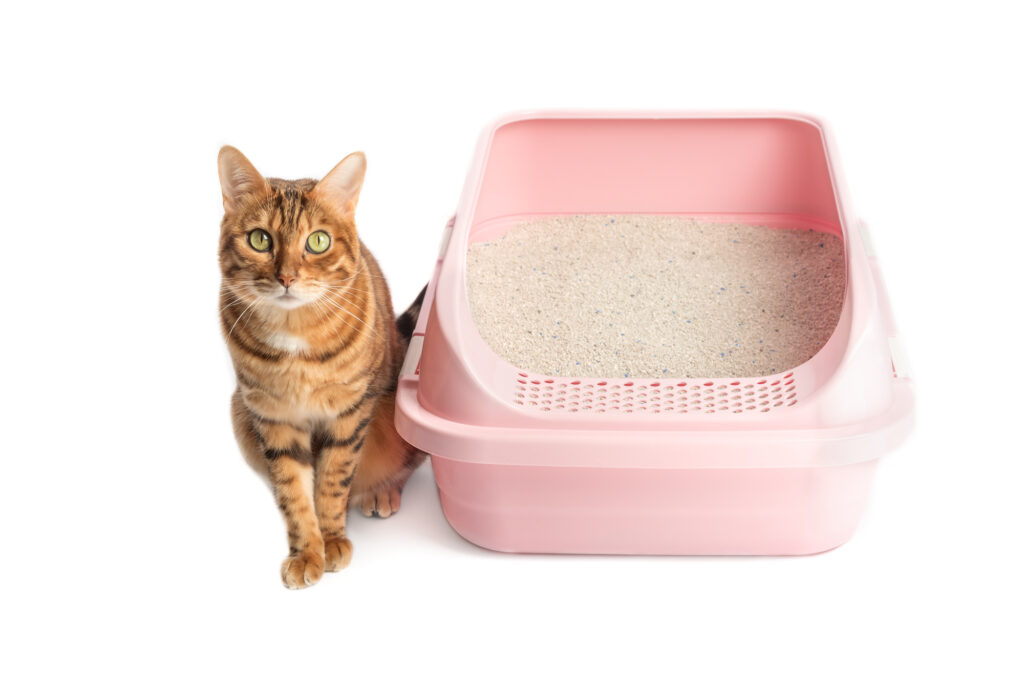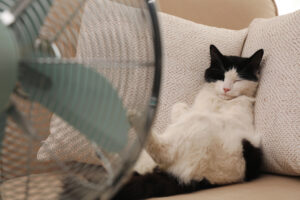
What is Positive Reinforcement Cat Training
Some folks claim that training a cat is impossible. They are completely mistaken. Cats are true experts when it comes to training; in fact, they have the whole concept nailed. Just consider how they’ve conditioned YOU to satisfy their every whim: when they meow, you bring food. When you pet them, they will jump up on your lap. They are experts at getting what they want from you. You can learn to guide your cat’s behavior through the use of positive reinforcement, so we can turn the tables on them. Cats, we’ve figured out your game; now play by our rules! No way!

Boarding Clients!*Discount does not apply during holiday/peak rate periods.

What is Positive Reinforcement?
The term “reinforcement” describes any action that will lead to the repetition of a desired behavior in an animal or human. In contrast, the “punishment” is to discourage the repeat of certain behavior. By “positive” and “negative,” behaviorists do not mean that one is inherently better than the other. It means something is added or given, it is considered positive; when something is taken away, it is considered negative. For instance, when your cat sits on your lap and you stroke them, it’s a good example of positive reinforcement because they get something out of it. As a result, they now frequently cuddle up to you while you watch TV, which is a successful example of reinforced behavior.
Positive Reinforcement for Good Cat Behavior
When saying “training” a cat, what exactly does that mean? It means that you can train your cat to do anything you want, not just tricks. Many desired behaviors—like scratching a scratching post—may be a replacement for undesirable ones—instead of carving up a favorite armchair into pieces the size of matchsticks. The most critical thing is to identify the factors that encourage your cat to display a desired behavior and then use that behavior as a reward to encourage it to repeat itself and avoid the other undesirable behavior.
Things You Can Train a Cat to Do
Using positive reinforcement, you can alter your cat’s routine habits in the following ways:
Come When Called
Train your cat to come to you when you call their name or use a specific sound, like a clicker or a bell.
Use the Toilet or Litter Box
Litter training is one of indoor cats’ most basic and essential training. You can also train them to use a human toilet, although it requires patience and consistency.
Sit on Command
Similar to dogs, cats can be trained to sit on command, which can be useful in various situations, such as during grooming or vet visits.
High Five or Shake Hands
With positive reinforcement, you can teach your cat to give a high five or shake hands, which is a fun party trick.
Walk on a Leash
With the right harness and patience, you can train your cat to walk on a leash, allowing them to safely explore the outdoors.
Stay or Wait
Training your cat to stay or wait on command can be very useful for preventing them from dashing out the door or jumping off a balcony.

Fetch
Some cats naturally enjoy fetching small objects, and with encouragement, they can learn to bring them back to you.
Use Scratching Posts
Redirecting your cat’s natural scratching behavior to appropriate surfaces like scratching posts can save your furniture and provide them with a healthy outlet.
Stop Unwanted Behaviors
With consistent training, you can teach your cat to stop behaviors like scratching furniture, jumping on counters, or biting.
Perform Tricks
Cats can learn a variety of tricks, such as jumping through hoops, rolling over, or playing dead, especially when motivated by treats or play.
Go to Their Bed or Crate
Training your cat to go to a specific spot, like their bed or crate, on command can be very helpful for travel or when you need them to settle down.
Be Comfortable with Handling
Acclimating your cat to being handled can make vet visits and grooming sessions much easier. This includes getting them used to having their paws touched, being brushed, and being held.
Positive Reinforcement Methods for Cat Training
Treats
Fortunately, a lot of cats are food-motivated, meaning they enjoy treats, which works great as a reward in many situations.
Affection and attention
Affection, sweet talk, or even a brief game with a favorite toy can be used as a reward for cats that don’t react well to food or are on a restricted diet.
Clicker Training
You can use a clicker, which, after your cat learns to associate the sound with a treat, serves as a positive reinforcement tool. Showing your cat that you have what they want and can make it theirs is the basic idea. Everything will be fair game once they understand your instructions.
Benefits of Positive Reinforcement in Cat Training
There are many advantages to training cats that apply to owners as well as cats themselves. Cats can learn a lot of new tricks and commands with the right amount of time, persistence, and positive reinforcement, contrary to popular belief. Among the many advantages of cat training are the following:
Improved Behavior
You can influence your cat’s behavior, set limits, and promote desirable behaviors.
Enhanced Bonding
You and your cat can enjoy quality time together during training sessions.
Mental Stimulation
Your cat’s brain will stay active and prevent destructive behaviors like boredom when it learns new tricks and behaviors.
Enriched Environment
Training encourages your cat to explore their environment in a safe and controlled manner.
Improved Communication
You can achieve a harmonious relationship by teaching them commands and cues, which will help you communicate your expectations and desires effectively.
Stress Reduction
Training can alleviate some of the anxiety that comes with going to the vet, traveling, or dealing with changes around the house.
Prevention of Problem Behaviors
You can lessen the severity of these problems by teaching your cat new behaviors.
Safety
Having a cat that is well-trained and responsive to commands can be extremely helpful in times of emergency.
Enriched Quality of Life
As they gain knowledge and practice new habits, it challenges their minds, gets them moving, and gives them a sense of pride in their achievements.
There are many ways in which cat training helps cats and their owners lead better lives. You can enhance your bond with your cat and help them reach their full potential through regular training sessions and the use of positive reinforcement techniques.

FAQs on Cat Training
Q: What are some essential commands I can teach my cat?
A: Some essential commands you can teach your cat include sit, stay, come, lie down, leave it, and get off.
Q: How do I teach my cat to sit?
A: To teach your cat to sit, hold a treat close to their nose and slowly move your hand upwards. As their head follows the treat, their bottom will naturally lower into a sitting position. Once they are sitting, reward them with the treat and praise.
Q: How do I teach my cat to stay?
A: Start by having your cat sit. Then, hold your hand out towards them and say “stay” while taking a step back. If they remain in place, reward them with a treat and praise. Gradually increase the distance and duration of the stay command.
Q: How do I teach my cat to come when called?
A: Use a clicker or treats to associate the command “come” with positive reinforcement. Call your cat’s name followed by the command, then reward them when they come to you. Practice in a quiet environment and gradually increase distractions.
Q: How do I teach my cat to lie down?
A: Start with your cat in a sitting position. Hold a treat near their nose and slowly move it towards the ground. As they follow the treat, their body will naturally lower into a lying down position. Reward them with the treat and praise when they lie down.
Q: How do I teach my cat to get off furniture or counters?
A: Use positive reinforcement by rewarding your cat when they voluntarily get off furniture or counters. You can also train them to go to a designated area instead, such as a cat tree or bed, and reward them for choosing that spot.

Q: How do I teach my cat to leave something alone?
A: Use positive reinforcement to redirect your cat’s attention away from the object they shouldn’t be touching. Offer them an alternative, such as a toy or scratching post, and reward them when they interact with it instead.
Q: What are some fun tricks I can teach my cat?
A: Some fun tricks you can teach your cat include high-five, roll over, fetch, spin, and jumping through a hoop. Be patient and use positive reinforcement to encourage them to learn new tricks.
Q: Are cats easy to train?
A: Cats can be trained, but they have their unique personalities and may require patience and consistency. Positive reinforcement techniques and understanding your cat’s motivations can make training easier.
Q: What should I train my cat to do first?
A: Start with basic commands such as sit, stay, and come. These commands provide a foundation for more advanced training and help establish communication between you and your cat.
Q: Why won't my cat get off the counter?
A: Cats may enjoy being on counters because they provide a high vantage point and access to interesting smells. Use positive reinforcement to train your cat to stay off counters by offering alternative spots for perching and rewarding them for staying off.
Q: What is single cat syndrome?
A: Single cat syndrome refers to behavioral issues that may arise in cats who are the only pet in the household. These issues can include boredom, anxiety, and destructive behavior. Providing environmental enrichment, regular playtime, and training can help alleviate single cat syndrome.


















